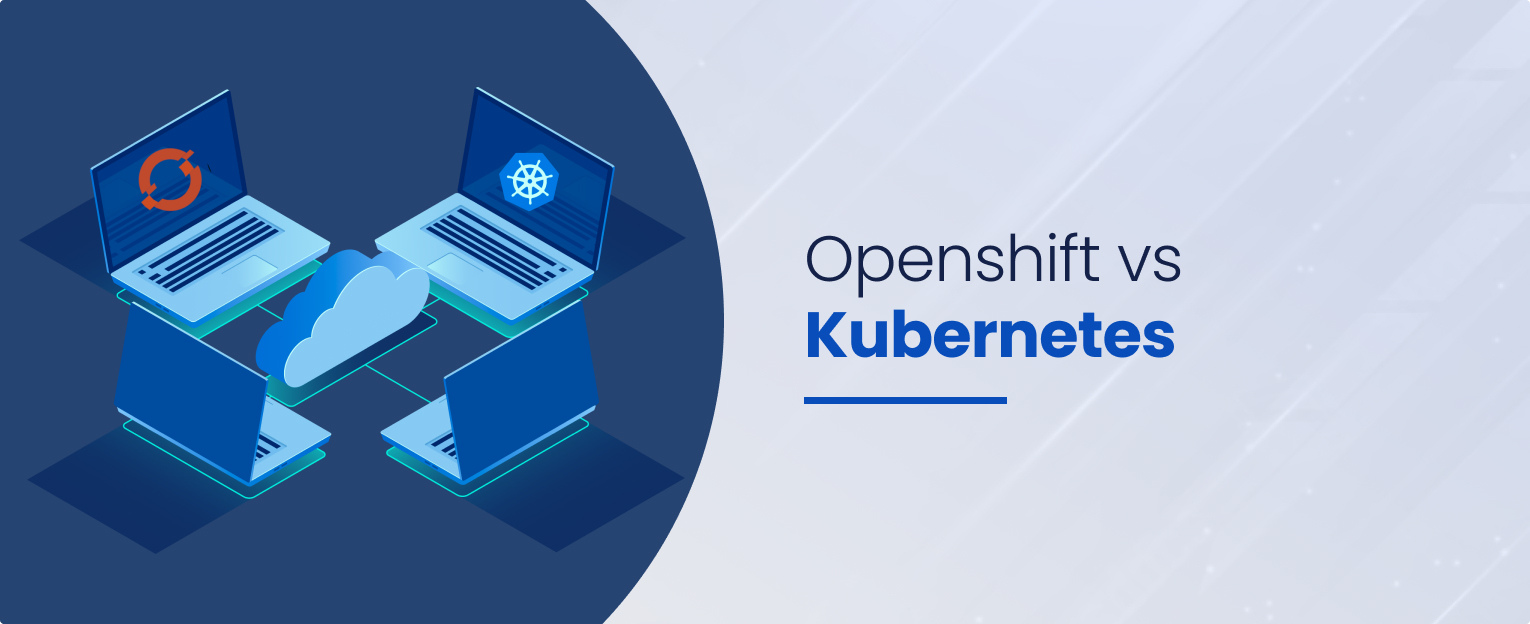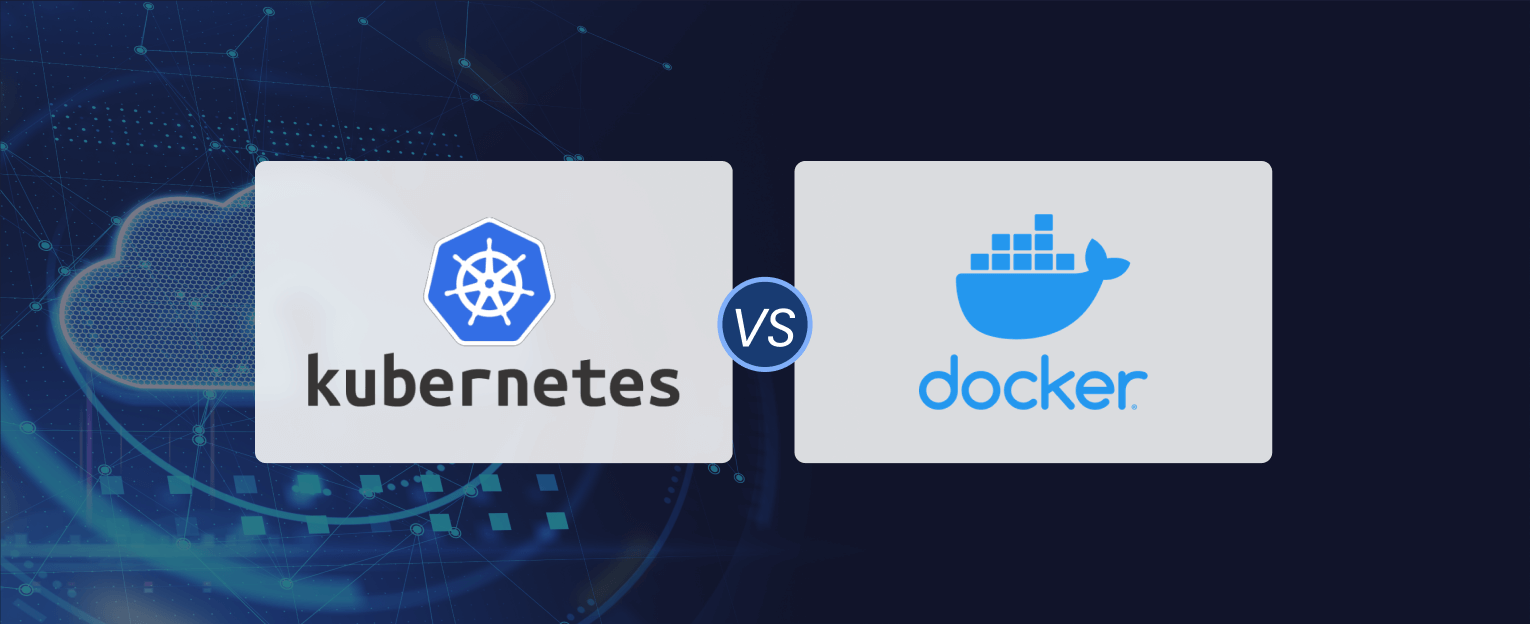In this post, we’ll address the significant divides between Openshift vs Kubernetes, discussing their respective features and capabilities and the situations in which you choose one or the other.
Containerization technology has partially revolutionized IT infrastructure and application deployment. It enables the efficient and flexible creation, management, and deployment of apps.
Two prominent platforms stand at the forefront of container orchestration solutions. In addition to open-source platforms such as Openshift vs Kubernetes, more and more young tech companies are adopting these design strategies.
Many refer to Kubernetes as the official standard for container orchestration. It ushered in a radical change in how applications are managed in distributed systems. Developed by Google and eventually open-sourced, Kubernetes delivers a robust system for failing over, scaling out, and managing applications deployed in their container form.
On the contrary, OpenShift has a background in Kubernetes and improves the latter by adding more features and boosting the quality of the enterprise-level options. Hence, OpenShift provides a robust solution for containerized application development, deployment, and management that suits the dynamism of modern business customers.
Critical Differences Between OpenShift vs Kubernetes
While Openshift vs Kubernetes both support containerization, understanding their distinctions is critical when comparing them. Although the two systems are container orchestration systems, they have different features and are designed for other users.
Kubernetes and OpenShift serve different purposes in the container orchestration landscape. OpenShift provides a user-friendly platform based on an opinionated platform with ready-made applications.
At the same time, Kubernetes offers a flexible platform based on a modular platform for fine-tuning containerized loads. Such comprehension is among the mandatory factors for organizations assessing the appropriate option for their particular need.
1. Opinionated vs Modular Approach
OpenShift imposes an opinionated stance. It offers a roundtrip platform with all pre-configured components already in place and all workflows ready. This implies that an OpenShift package offers a templated and standardized environment.
In contrast, Kubernetes has adopted a modular approach. After completing the initial functionality, users can modify the functions to their specific needs. Kubernetes’s environment is more open than other systems that require users to build their solutions from scratch.
2. Ease of Use vs Flexibility
OpenShift’s critical feature is its simplicity. This software helps deploy and operate applications based on containers. It provides a drag-and-drop interface for consistent user interface creation and developer-friendly tools to simplify application development.
Kubernetes, however, demonstrates flexibility, allowing users to manage every component in a full-stack containerized environment and orchestration. This flexibility offers a whole set of customization options, which may imply learning more curves.
3. Built-in Capabilities
OpenShift contains many built-in or constructed facilities, such as monitoring, logging, and CI/CD pipelines. These features are integral to the platform so that users can access them easily.
Kubernetes primarily deals only with the core orchestration processes, which generate the foundation for container deployment, scaling, and management. Although Kubernetes supplies the capability of third-party integrations and plugins, the necessity for additional control mechanisms, like CI/CD, may arise in the process of building automation.
4. Developer vs Infrastructure Focus
OpenShift emphasizes an aDevEx toolkit created to save developers time and increase productivity. It also has features such as S2I builds or an application development developer’s console that simplify the application development process.
Kubernetes, contrastingly, is a low-level solution that operates on the infrastructure layer, offering powerful primitives for handling containers and clusters. Kubernetes has APIs for auto-scaling and integration, but with a developer-focused set of tasks, the tooling needed is a bit more.
What is Openshift?
OpenShift is a complete container platform created by RedHat, a successful enterprise that develops container orchestration and management by applying progressive methods. Primarily, OpenShift is Red Hat’s distribution of Kubernetes, which refers to the most popular open-source container orchestration platform.
However, the valuable feature of OpenShift differentiates it from other technologies based on Kubernetes. These improvements called for eliminating complexities for the developers and making it easy to use Kubernetes.
Through simplifying Kubernetes usage, OpenShift provides an environment where developers can utilize this technology more efficiently, thus increasing the speed and efficiency of developing these applications.
The OpenShift product is based on Kubernetes’ competence combined with Red Hat’s expertise in enterprise solutions. Thus, it creates a comprehensive platform that addresses modern application development and deployment needs.
OpenShift Architecture Overview
OpenShift has evolved Kubernetes by adding some entrepreneurial abstractive levels to its environments and by providing easy-to-use tools for developers. Here’s an overview of the architecture:
Kubernetes Core Components Integration
OpenShift is based on Kubernetes’ command structure, which includes the API server, the controller manager, the scheduler, and the kubelet for container orchestration. That is why OpenShift’s major parts form the basis of its architecture, providing container management and cluster functionality.
Higher-Level Abstractions
In addition to the essential Kubernetes constructs, OpenShift adds subsequent abstractions to set up application deployment and control. Such abstractions as Projects, Routes, and BuildConfigs ensure that developers can define their application-specific configurations and working order by avoiding any physical Kubernetes conflict.
Operator Framework
OpenShift integrates the Operator framework, an operator-driven extensible toolkit for developing and managing complex applications with Kubernetes.
Operators serve as the Kubernetes engine extensions and aim to automatically delegate tasks such as application lifecycle management, configuration updates, and load balancing based on principles defined by the operator.
Developer Tools
OpenShift has an outstanding combination of tools and productivity features that assist software engineers in their tasks. These tools include:
- Developer Console: An interactive internet-based platform for application programming, deployment, and support of Kubernetes-related activities without users having to work in the background.
- Monitoring: Each layer or service has integrated monitoring features that enable the developers to keep track of the application and cluster health and performance.
- CI/CD Pipelines: They incorporate continuous integration and deployment pipelines to visualize and automate applications’ building, testing, and deployment processes.
Outlining the Kubernetes core components and using more advanced layers, Provider Framework, and functionality dashboard, OpenShift offers a comprehensive and user-focused platform that one can deploy, manage, and scale his containerized applications effectively.
The architecture does the latter, thus deducting the developers of the time they would have spent using extra energy for managing the Kubernetes infrastructure as it abstracts successive complexities away.
What is Kubernetes?
Kubernetes is an open-source platform that orchestrates containerized applications. There has been a significant shift from traditional deployment methods to scaling and managing applications running on cloud environments.
The Kubernetes project was initially developed within Google’s labs and later given to CNCF as an open-source project under the umbrella of the Cloud Native Computing Foundation (CNCF). It has become one of the most successful projects and has gained wide publicity there.
Primarily, Kubernetes automates the complex process of managing containerized applications in that it affords a robust deployment, scaling, and monitoring platform. Kubernetes reduces the complexity of infrastructure management, and peripheralizing allows developers to concentrate on shipping and developing the applications without any fear of bothering the underlying infrastructure, one of the many benefits of Kubernetes.
Users can define desired states for applications by utilizing Kubernetes, which uses orchestration among containers to guarantee that the desired state is maintained.
For instance, these activities contain functions like load balancing, resource allocation, and auto-scaling, which are recommended for use based on the required demand, making Kubernetes irreplaceable when developing and deploying modern cloud-native applications.
Kubernetes Architecture Overview
Kubernetes is a single system that comprises several layers of components and objects, the master ones being only one of them, designed for managing containerized applications. Here’s an overview of its architecture:
Kubernetes Master Components
Master components of the Kubernetes API server, controller manager, scheduler, etcd. Add up the Kubernetes clusters.
- API Server: This is the primary interface between all Kubernetes components, such as the API endpoints and the Kubernetes control plane.
- Controller Manager: Using sensor updates from one controller, the manager monitors the cluster state and administers different controllers to stay close to the desired state.
- Scheduler: The placement of pods in the nodes depends on the node’s resources available and other constraints.
- etcd: A master key-value store that will accept cluster configuration and operation state grammar instead of only cluster information.
Kubernetes Nodes
Kubernetes node era takes care of putting the application in play. Correspondingly, with each node, this will likely encourage more pods residing in the same node, the smallest deployable unit in Kubernetes.
- Kubelet Agent: A Kubernetes node acts as the proxy for the kubelet agent, which is a liaison between the master’s components. The primary responsibility of the Kubelet is to have its pods running on the node and ensure they are healthy.
Kubernetes Objects
Kubernetes relies on multiple objects to break up the desired state of a cluster and its parts. These objects include:
- Pods: Pods are node groups containing one or more containers running on a bus. They aggregate container instances to form Kubernetes applications.
- Services: This abstraction would include access methods and pod rescheduling. Services enable load balancing across the cluster and allow data to be located in the cluster.
- Deployments: Declaratively state the Pod replicas and roll out updates. Rollouts are set up to guarantee that the determined number of pod replicas is running by observing any changes in the application.
Kubernetes architecture can ensure that an application is still running at scale, has remarkable resilience, and is self-healing. It can be exclusively used to orchestrate containerized processes.
The masters act not only to control all activities but also to manage and supervise all the nodes, whereas nodes maintain the defined state depicted in the Kubernetes Objects.
Use Cases
OpenShift
- Developer-Focused: The OpenShift environment is geared toward software developers who create and run modern cloud-native applications. This helps simplify the design, provisioning, and management of containerized applications.
- Cloud-Native Applications: Shift can help companies use cloud-native architecture and microservices-based applications. It provides a developer-friendly tool that can boost application development and delivery.
Kubernetes
- Infrastructure-Focused: Kubernetes mainly targets deploying and scaling containers within a distributed infrastructure. It is tailored for heavy-duty usage, such as running and connecting larger systems in production environments.
- Scalability and Flexibility: Kubernetes offers a highly scalable and agile platform for making and deploying applications. It ensures that it is supported by several deployment models, including on-premises, cloud, and hybrid/multi-cloud deployments.
OpenShift
- Preferred for Superficial Apps: OpenShift, on the other hand, gets many votes for porting applications that are not very complicated. Its developer-minded orientation and toolkit allow it to rapidly prototype and deploy lean applications.
Kubernetes
- Flexibility for Complex Deployments: Kubernetes can become an excellent tool for companies with specific deployment needs or those working in hybrid/multi-cloud environments. It gives particular access to the supervision and operation of containers, serving multiple use cases and environments.
Key Considerations Difference Between Kubernetes and Openshift
Two prominent names often arise when navigating the container orchestration: Kubernetes and OpenShift. Understanding their key OpenShift and Kubernetes differences is crucial for making informed decisions in deploying and managing containerized applications.
Let’s delve into the key considerations differentiating Kubernetes and OpenShift:
Ease of Use vs Flexibility
- OpenShift: OpenShift seeks to optimize usability through pre-built applications and user-friendly workstreams. It simplifies many of the Kubernetes complex philosophies by hiding or presenting them in a form developers can use, thus making it easy to deploy and manage applications.
- Kubernetes: In contradiction, Kubernetes has a modular architecture, which gives more flexibility. Although it requires adapting to a steeper learning curve, Kubernetes provides much richer control and customization over the platform.
Developer Experience vs Infrastructure Focus
- OpenShift: OpenShift focuses on the developer’s needs. This approach is assisted by the developer’s experience-oriented tools and features. It provides IDEs, CI/CD pipelines, and comprehensive developer-centric features to enhance the code development speed.
- Kubernetes: Kubernetes has performed poorly in managing infrastructure and orchestration. Though APIs for developers are provided, it is primarily a tools for infrastructure operators tasked with deploying and maintaining containerized workloads.
Built-in Capabilities vs Modular Architecture
- OpenShift: The platform’s capabilities are not limited to monitoring, logging, and CI/CD pipelines; instead, they encompass a range of other features, such as assured security, high availability, and 24/7 support. These properties were developed into the platform and are kept together, minimizing the deployment and management process.
- Kubernetes: Kubernetes aggregates the procedures in a modular design, allowing customers to select the tools and components that best suit their needs. Kubernetes merely provides the orchestration’s base, but users can connect many other tools and modules of various third-party vendors for functional enhancement.
Level of Control Over the Environment
- OpenShift: With OpenShift, instead, the individual complexity of Kubernetes is hidden, making the platform more straightforward to use. However, it still is opinionated. Even though the simplicity of rollout and management is possible compared to the flexibility of the user inputs, they may not have control over the environment.
- Kubernetes: Among Kubernetes’s differentiating functions, the granular control over the environment, where users can fine-tune and customize every deployment detail accordingly, stands out. This level of control fits the requirements of organizations with many complex or unique instructions.
Skill Sets Required for Management and Maintenance
- OpenShift: OpenShift is designed to facilitate using similar competencies, which are not very different from managing and serving Kubernetes.
- Kubernetes: This usually implies that Kubernetes is a more fully-fledged package that requires advanced infrastructure management skills. However, companies may have to allocate dedicated teams or experts with knowledge of Kubernetes.
Integrations with Other Parts of the Technology Stack
- OpenShift: OpenShift integrates smoothly with other parts of the technology stack, such as Container registries, CI/CD tools, and monitoring tools. This module’s more or less fuse allows developers and deployers easy movement.
- Kubernetes: Kubernetes allows users to utilize multiple tools and services in the cloud-native community. Thanks to its openness to sources and large media community, our software is easily compatible with different devices and technologies. Innovations in renewable energy are transforming various sectors, from US agriculture to electricity generation.
Costs and Licensing Considerations
- OpenShift: OpenShift could mean extra expenditure because it is often coupled with enterprise-level support services, which can either be unavailable or cost a lot in open-source Kubernetes.
- Kubernetes: Although Kubernetes is open-source and operates on the exact cost model as other open-source software, organizations can encounter costs, including infrastructure, support, and extra tools and services that may be integrated with Kubernetes.
Conclusion
The comparison of Openshift vs Kubernetes presents their outstanding features and underlines their use cases. OpenShift stands out with its developer experience and ease of usage, which make it a fitting framework for organizations that strive to develop apps quickly.
On the contrary, Kubernetes provides greater flexibility and more control over the infrastructure that works well across complex and hybrid environments. You should bear in mind that fact, which implies that the choice of OpenShift or Kubernetes isn’t binary.
Organizations can benefit from both solutions that best fit the needs of their specific environment. Ultimately, analyzing these factors matters in finding the correct approach for container orchestration and operations.
- Frequently Asked Questions
Q1. What is the difference between OpenShift and Kubernetes?
OpenShift is a PaaS (platform as a service) offered by Red Hat. It is a superstructure on Kubernetes, giving extended features and possibilities for faster app development and management. In contrast, Kubernetes is an open-source container orchestration system created by Google and donated to the Cloud Native Computing Foundation.
Q2. Is OpenShift using Docker?
The OpenShift Container Platform uses Docker as one of the leading container runtimes for running applications inside containers. Docker provides a simplistic approach to packaging, transferring, and running applications inside containers.
Q3.What is OpenShift vs EKS?
OpenShift, from Red Hat, offers a developer-friendly experience with built-in features like monitoring and CI/CD, while EKS by AWS provides scalability and seamless integration with AWS services.
Q4. Does Redhat OpenShift use Kubernetes?
Red Hat OpenShift is a Kubernetes-based platform. It deploys Kubernetes as its core container orchestration engine. In addition to the addition of different levels of abstraction and tools on top of Kubernetes, this platform is a better all-around containerized application development, deployment, and management environment.







